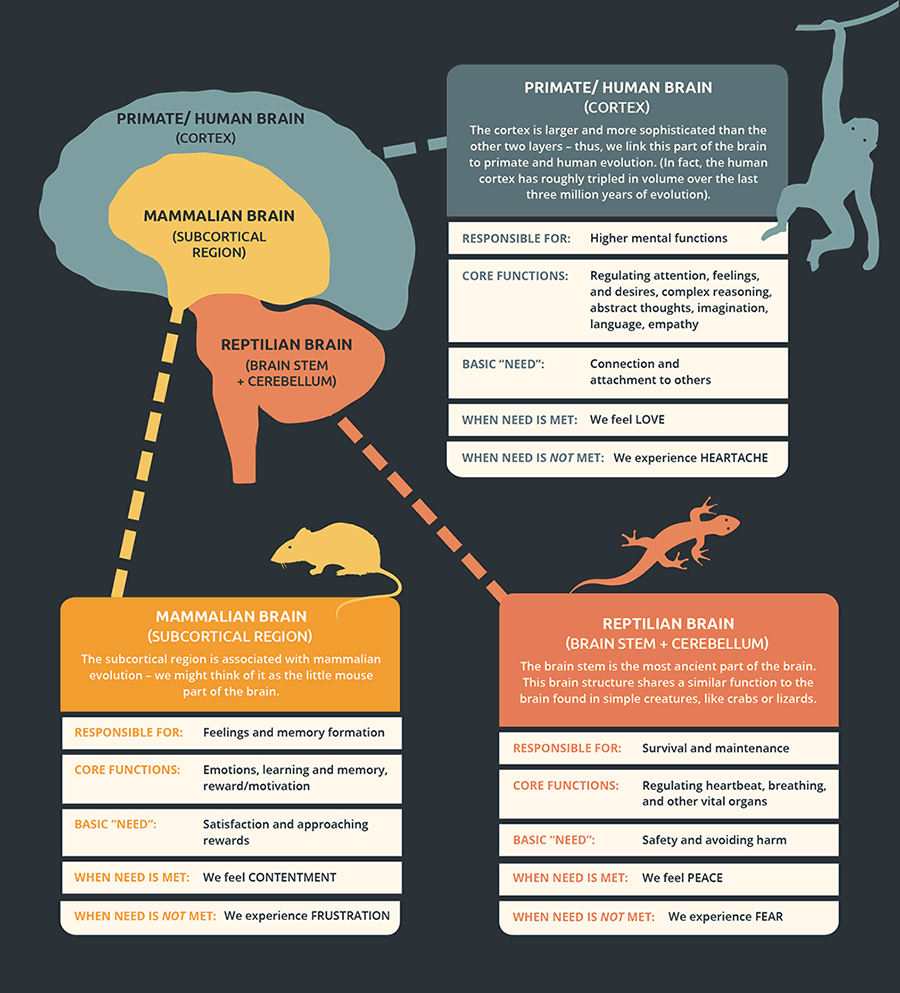
SOMATIC EXPERIENCING
Somatic Experiencing is a method based on in-depth research in our nervous system; how it is constructed, how it can become deregulated, but also how it can regain its resilience. It is a gentle, respectful method, designed to increase our capacity to live life with a sense of safety, aliveness and connection.
How does Somatic Expression work?
Our brain is an important part of our nervous system and roughly consists of three parts. These three parts are connected to the rest of the body via nerves. I use the layout of our brain as an entry point to briefly and simplified explain how Somatic Experiencing works.
Brainstem (reptile brain)
This is the oldest part of our brain and developed first. Its main function is to detect insecurity and to initiate fight, flight or freeze reactions based on this. Since this function determines our survival, it also has by far the greatest impact. This means that when it becomes unsafe, the feeling of fight or flight prevails. These sensations strongly color the functions of the other parts of the brain. Freezing happens when fighting and flight no longer makes sense.
Limbic part (mammal brain)
This part originated after the reptilian brain and literally formed on top of it. It regulates our emotions. It allows mammals to nurse their little ones and live in groups. It is the system that regulates need and satisfaction. It is heavily influenced by the reptilian brain. When the reptilian brain is activated, this colors our emotions.
Cortex (human brain)
This part was developed most recently. It has formed around the limbic part. We use this part for language and imagination, analysis and reasoning. But it also controls more subtle emotions like empathy. The cortex, in turn, is heavily influenced by the reptilian and mammalian brain. When we have strong emotions, our stream of thoughts not only increases, but it also gets louder.

Deregulation
There are countless events in a human life that have an impact on our nervous system. Some contribute to more regulation and organization and others cause disruptions. You can imagine a network of power plants connected with a lot of cables, which in turn is connected to other networks. When a very high voltage enters our network that we are not prepared for, it can damage the cables and the exchanges. When a situation arises that is “too much”, our system tries to regulate the overvoltage as best it can. This is not always possible for our body and mind, which leads to deregulation. The energy from the surge is secured somewhere to prevent further damage. Examples of such situations are; a car accident, a fall, prolonged stress at work, growing up in unhealthy family situations, being ill or in pain for a long time, painful experiences in intimate relationships, too little physical contact and more.
The above examples are all cases where there is a rupture in the need of our nervous system. Break on security, break on physical and emotional needs, but also break on unconditional love. This causes deregulation in the functions of the corresponding brain parts described above and makes it less pleasant for us to go through life. After all, we don't feel completely safe somewhere, and/or are usually frustrated or annoyed that our basic needs have not been met, and/or we don't feel loved the way our heart desires.
Regulation
Disruptions arise because at the moment of an event it is not possible for our nervous system to process the overvoltage. The overvoltage then remains stuck somewhere in the system. Regulation occurs when sufficient capacity is built up to easily allow the secured overvoltage to flow again slowly and in a titrated manner. The emotions associated with holding the span are admitted and felt in manageable amounts. This restores confidence in our own body and its capaciteit, which result in sensing our strength and aliveness. Because the energy that was needed to control the overvoltage is now free to celebrate life.
If you would like more detailed information about Somatic Experiencing, you can check out Peter A. Levine's books “The Tiger Awakens” and “The Voice of Your Body”. Although good information gathering is very important, as with many things, you can also get to know SE better by experiencing it. After all, from reading a lot about chocolate, you can't taste chocolate.
Somatic Experiencing and NARM together are very effective therapy models. Plan a 30 minute online intake, free of charge to ask your questions and have a sense of the sessions.
